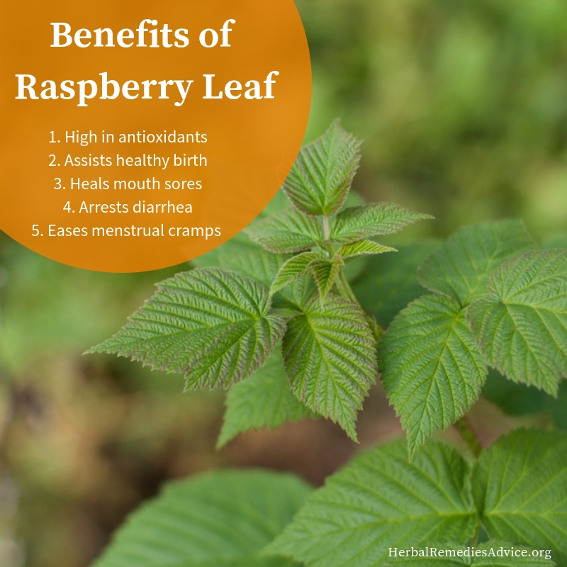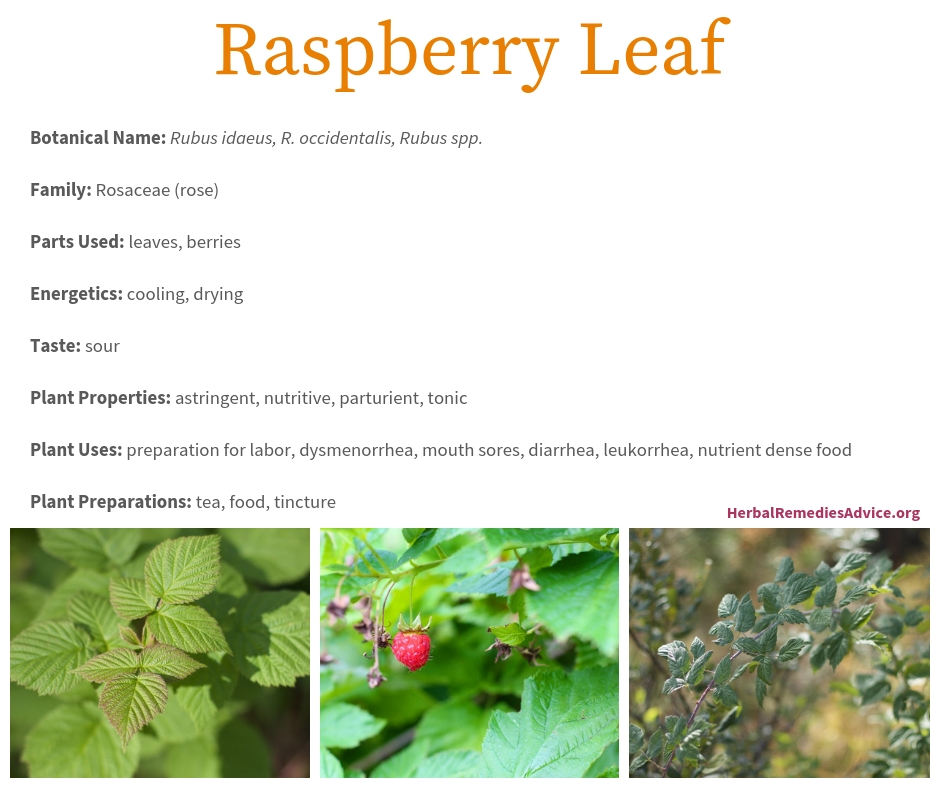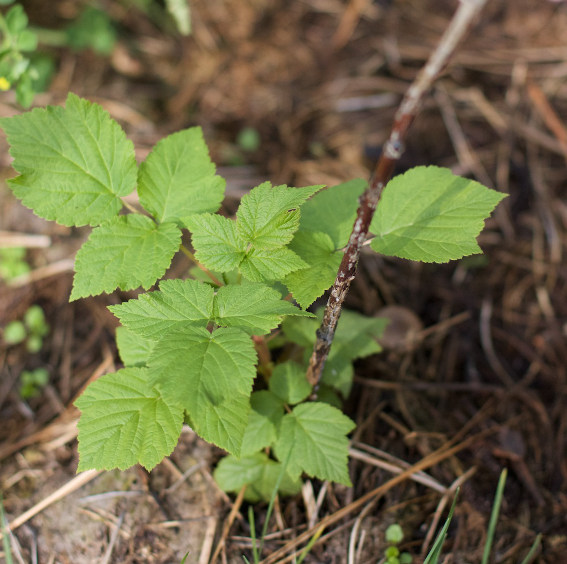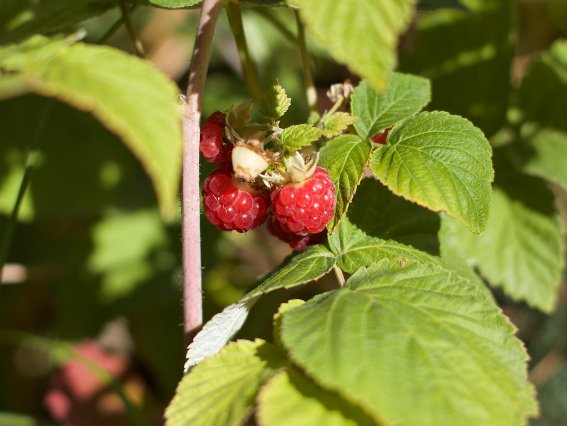Get weekly tips, recipes, and my Herbal Jumpstart e-course! Sign up for free today.

Raspberry Leaf Uses
Share this! |
|
As spring emerges in the raspberry bramble, you can find new curved canes bursting with leaf buds. Soon they will unfurl and become one of our most nutrient-dense and astringent herbs. That’s right, while the juicy berries of the summer get all the glory, red raspberry leaf uses are numerous and have many gifts to share.
Red Raspberry Leaf Uses as an Astringent
To best understand red raspberry leaf’s uses you first have to employ your senses.
A strong red raspberry leaf tea is the perfect place to start. Taking a few sips you may notice the floral scent and taste, but there is also the tannic feel of astringency. (You’ll recognize this sensation if you’ve ever eaten an unripe banana or had a strong cup of black tea.) What is most noticeable is the dry feeling it leaves in your mouth. This impression is caused by the tightening and toning of your mouth tissues. And while it is most obviously felt in your mouth, astringent herbs can have a similar effect throughout the body.
You may not often find yourself discussing astringency with your friends or family, but this is one of the most important and oddly helpful actions within the herbal world.
By tightening and toning tissues, astringent herbs, like red raspberry leaf, can address all sorts of lax tissue states and thereby reduce excess discharges and keep moisture in the tissues where it belongs.
Let’s begin with your mouth. Red raspberry leaves are known for their ability to address inflammation in the mouth and throat and can be used as a mouth wash or gargle for spongy gums, mouth ulcers, or a sore and swollen throat.
Do seasonal allergies or a cold have you feeling like a leaky faucet? Herbalist Matthew Wood says, “[Red raspberry] is my remedy of choice for allergies or influenza with copious free discharge of clear mucus from the upper respiratory tract.”1
It is commonly used in the same manner as its cousin, the blackberry, for non-infectious diarrhea, its tonic actions helping to slow the bowels and prevent excess fluid loss. It is widely used in this way by many First Nations peoples, including the Okanogan, Cherokee, Cree, Iroquois, and Algonquin.2
Eclectic herbalists and modern day herbalists alike use it for leukorrhea (excessive non-infective vaginal discharge) and spermatorrhea (excessive involuntary ejaculation).3
Red Raspberry Leaf Uses to Tone the Uterus
While references to red raspberry leaf uses in Western herbalism date back hundreds of years, it is only relatively recently that they have become commonly used to support uterine health.
Taken regularly, red raspberry is used to help those who have painful cramps during menstruation. It is often combined with nettle and spearmint and taken long term for the best benefit.
Red raspberry is often used to support the uterus in the last trimester of pregnancy and to help prepare for birth. It is also valued for its ability to restore uterine integrity in the postpartum. Eclectic herbalists recommended red raspberry for uterine prolapse.4
“The leaf contains phytosterols. It strengthens the reproductive system, and relaxes smooth muscles in the uterus. It is often recommended in treatments for amenorrhea, anemia, dysmenorrhea, and menorrhagia.”
Brigitte Mars, The Sexual Herbal
Red Raspberry Leaves and Berries are Nutritive
Both the leaves and berries of red raspberry are nutrient dense.
The leaves are high in magnesium and manganese.5 The leaves also contain phytonutrients like flavonoids and tannins.
Red raspberries and black raspberries are a delicious food high in nutrients and health-supporting properties.
The berries are exceptionally high in fiber for a fruit, containing about six grams of fiber per 1/2 cup.6 They are also rich in flavonoids and vitamin C.
Numerous studies have shown that regularly eating red and black raspberries can improve heart health by reducing high blood pressure and by improving cholesterol levels.7,8
Black raspberry fruits have been shown to have positive health benefits for people with pre-diabetes and type 2 diabetes. One study showed that black raspberries controlled blood sugar and reduced vascular inflammation in patients with pre-diabetes.9 Another trial showed numerous improvements, including reduced arterial stiffness for people with metabolic syndrome, a cluster of conditions that increase the risk for cardiovascular disease and diabetes.10
One study cautions that red raspberry leaf is so effective at addressing blood sugar levels it may lead to a reduced dependency on insulin. This study was aimed at women with gestational diabetes and recommends they keep their insulin levels closely monitored.11
There have also been some preliminary studies showing that black raspberry fruit extracts may play a role in cancer prevention.12,13
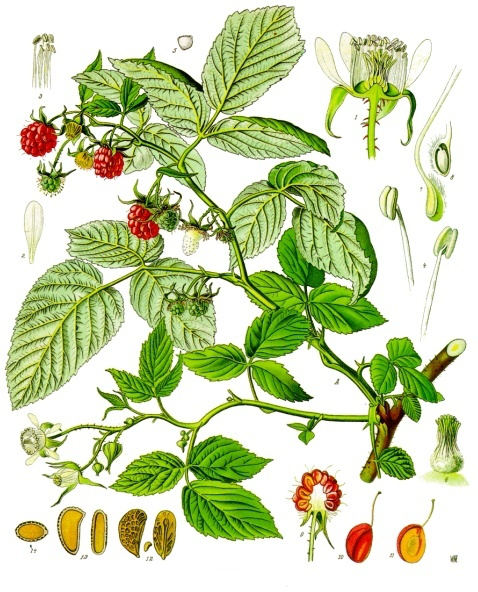
The Raspberry Leaf Herb
Rubus idaeus is a perennial shrub with biennial stems that grows anywhere from 3 to 9 feet tall.
The thorny canes emerge the first year as green stems and, depending on the variety, either don’t fruit or fruit very little. The second year, the canes will flower and fruit. At the end of the second growing season, the bark will turn brown and/or gray and the cane will die. It is recommended to prune the second year canes in the winter/early spring to avoid overcrowding of the raspberry patch.
Red raspberry leaves are pinnately compound with three to five leaflets. The underside of the leaf has a silvery green color and may be covered in small spines.
The flowers have five petals and numerous stamens, qualities often seen in the rose family. The flowers are white and grow in clusters.
The fruit is an aggregate, meaning that what we consider as one berry is actually many tiny berries gathered around a receptacle.
Use of Raspberry Leaf and Berry
Red raspberry leaves can be harvested whenever they look vibrant, ideally before the plant flowers and fruits. Leaves should be dried thoroughly before storing or using them.
Raspberries are a delicate fruit and only last for a few days after harvest. When choosing raspberries at the store or farmer’s market, look for berries that hold their shape and don’t leak juice.
Black raspberries are highest in flavonoids and are the basis for most of the studies regarding heart health and potential anti-cancer qualities.
When considering the berries for nutrients, it’s best to avoid yellow raspberries. According to Jo Robinson, author of Eating on the Wild Side, “To create the novel yellow color, breeders had to ‘silence’ the gene that produces anthocyanins – akin to removing the active ingredient from a prescription drug.” If you are interested in growing your own raspberries, Robinson recommends the colorful red cultivars, “The most nutritious of our present-day varieties include Heritage Red, Tulameen, and Caroline.”14
Due to their nutritional content, red raspberry leaves work best as a water-based extraction. They are often used in nourishing herbal style infusions or herbal vinegars. I recommend combining them with other herbs – if taken in too high of a dose, the astringency may turn your stomach.
Dosage Suggestions:
Raspberry Leaf Tea: 7-10 grams per day
Tincture: 1:5 dry herb, 30% alcohol, 3-5 mL three times a day15
Special Considerations for Raspberry Leaf Uses
Raspberry fruits and leaves are generally regarded as safe.
Citations for Raspberry Leaf Uses
Click to show/hide.
Rosalee is an herbalist and author of the bestselling book Alchemy of Herbs: Transform Everyday Ingredients Into Foods & Remedies That Healand co-author of the bestselling book Wild Remedies: How to Forage Healing Foods and Craft Your Own Herbal Medicine. She's a registered herbalist with the American Herbalist Guild and has taught thousands of students through her online courses. Read about how Rosalee went from having a terminal illness to being a bestselling author in her full story here.
